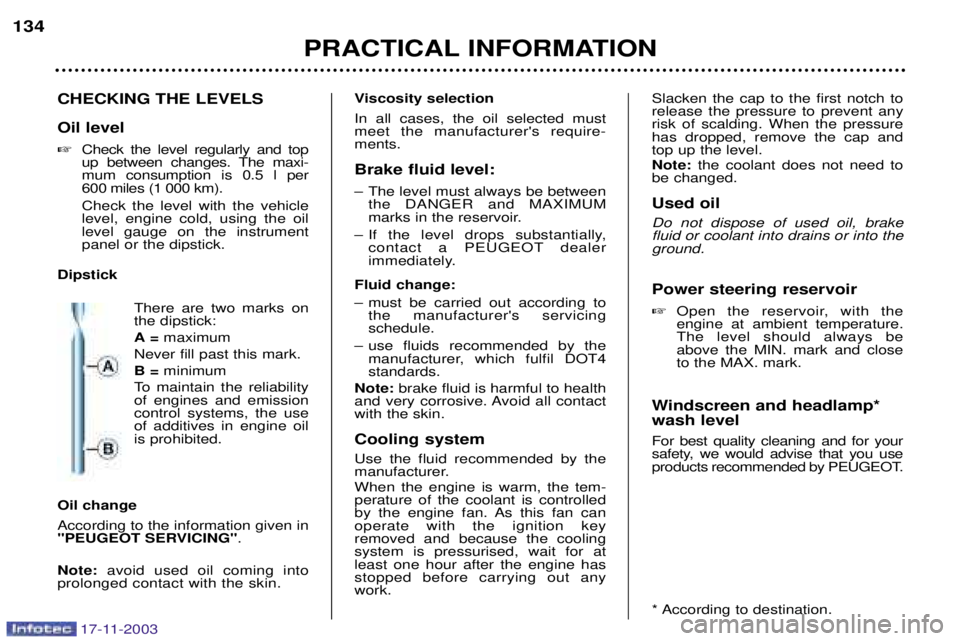Page 139 of 181
17-11-2003
PRACTICAL INFORMATION131
1 -
Power steering reservoir.
2 - Battery.
3 - Coolant reservoir. 4 -
Brake fluid reservoir.
5 - Air filter.
6 - Windscreen and headlamp wash
reservoir. 7 -
Fuse box.
8 - Engine oil filler cap.
9 - Dipstick.
2 LITRE PETROL INJECTION ENGINE
Page 140 of 181
17-11-2003
PRACTICAL INFORMATION
132
1 -
Power steering reservoir.
2 - Battery.
3 - Coolant reservoir. 4 -
Brake fluid reservoir.
5 - Air filter.
6- Windscreen and headlamp wash
reservoir. 7 -
Fuse box.
8 - Dipstick.
9 - Engine oil filler cap.
2.0/2.2 LITRE TURBO DIESEL HDI ENGINE
Page 141 of 181
17-11-2003
PRACTICAL INFORMATION133
1 -
Power steering reservoir.
2 - Battery.
3 - Coolant reservoir. 4 -
Brake fluid reservoir.
5 - Air filter.
6 - Windscreen and headlamp wash
reservoir. 7 -
Fuse box.
8 - Dipstick.
9 - Engine oil filler cap.
2.8 LITRE TURBO DIESEL HDI/TED ENGINE
Page 142 of 181

17-11-2003
PRACTICAL INFORMATION
134
CHECKING THE LEVELS Oil level �Check the level regularly and top
up between changes. The maxi-mum consumption is 0.5 l per
600 miles (1 000 km). Check the level with the vehicle level, engine cold, using the oillevel gauge on the instrumentpanel or the dipstick.
Dipstick
There are two marks onthe dipstick: A=maximum
Never fill past this mark.B= minimum
To maintain the reliability of engines and emissioncontrol systems, the useof additives in engine oilis prohibited.
Oil change According to the information given in
"PEUGEOT SERVICING" .
Note: avoid used oil coming into
prolonged contact with the skin.
Viscosity selection In all cases, the oil selected must meet the manufacturer's require-ments. Brake fluid level:
Ð The level must always be between the DANGER and MAXIMUM
marks in the reservoir.
Ð If the level drops substantially, contact a PEUGEOT dealer
immediately.
Fluid change:
Ð must be carried out according to the manufacturer's servicing schedule.
Ð use fluids recommended by the manufacturer, which fulfil DOT4standards.
Note: brake fluid is harmful to health
and very corrosive. Avoid all contactwith the skin. Cooling system Use the fluid recommended by the
manufacturer. When the engine is warm, the tem- perature of the coolant is controlled
by the engine fan. As this fan canoperate with the ignition keyremoved and because the coolingsystem is pressurised, wait for atleast one hour after the engine hasstopped before carrying out anywork. Slacken the cap to the first notch torelease the pressure to prevent anyrisk of scalding. When the pressurehas dropped, remove the cap andtop up the level. Note:
the coolant does not need to
be changed. Used oil Do not dispose of used oil, brake fluid or coolant into drains or into theground. Power steering reservoir � Open the reservoir, with the engine at ambient temperature.The level should always beabove the MIN. mark and closeto the MAX. mark.
Windscreen and headlamp* wash level For best quality cleaning and for your
safety, we would advise that you use
products recommended by PEUGEOT.
* According to destination.
Page 143 of 181

17-11-2003
Only use products recom-
mended by PEUGEOT.
To ensure best perform- ance from components as
important as the power steering andthe braking system, PEUGEOTselects and offers quite specificproducts.
CHECKS Battery
At the start of winter, have your bat-
tery checked by a PEUGEOT dealer. Air filter and passenger compartment filter Have the filter elements replaced
regularly. If you drive in dusty con-
ditions, change them twice asoften. Brake pads Brake pad wear depends on the style of driving, in particular for vehi-cles which are used in town, overshort distances. It may be necessary to check the thickness of the pads, even betweenservices. Handbrake Where the handbrake travel is too great or there is a reduction in theperformance of the system, thehandbrake should be adjusted, evenbetween services. Have the system checked by a
PEUGEOT dealer. Oil filter
Change the filter regularly, in accor- dance with the servicing schedule.
Fuel supply cut-off In a serious collision, a system pre- vents fuel from reaching the engine.
To re-establish the fuel supply, press the switch on the angle of the front
left-hand suspension assembly,under the bonnet.
PRACTICAL INFORMATION 135
Page 151 of 181
17-11-2003
Fuse no. RatingFunctions
8 30 A Wash-wipe pump.
9 15 A Headlamps and fog lamps.
10 15 A Horn - Steering wheel lever control.
11 15 A Engine management control unit (secondary).
14 10 A Right-hand dipped headlamp.
15 10 A Left-hand dipped headlamp.
16 7.5 A Engine management control unit supply - Transponder.
17 10 A Engine management control unit (primary).
18 7.5 A Engine management control unit - Transponder.
19 7.5 A Air conditioning compressor.
20 30 A PTC.
21 15 A Fuel pump.
22 20 A Engine management control unit (primary).
23 10 A Automatic gearbox.
24 15 A Automatic gearbox - LPG/CNG operation.
30 15 A Left- and right-hand main beam headlamps.
PRACTICAL INFORMATION 145
Page 157 of 181
17-11-2003
TOWING YOUR VEHICLE
Without lifting (4 wheels on the ground)
You must always use a tow bar. The towing eyes are located at the front and the rear under the vehicle's bumpers. Lifting (2 wheels only on the ground) It is preferable to raise the vehicle with a professional lifting device.Special features of the automatic gearbox When towing with four wheels on the ground, the following rules must beobeyed:
Ð lever in position
N,
Ð tow the vehicle at less than 30 mph (50 km/h) over a maximum dis- tance of 30 miles (50 km).
PRACTICAL INFORMATION
148
When towing with the engine switched off, thereis no braking or steeringassistance.
Page:
< prev 1-8 9-16 17-24